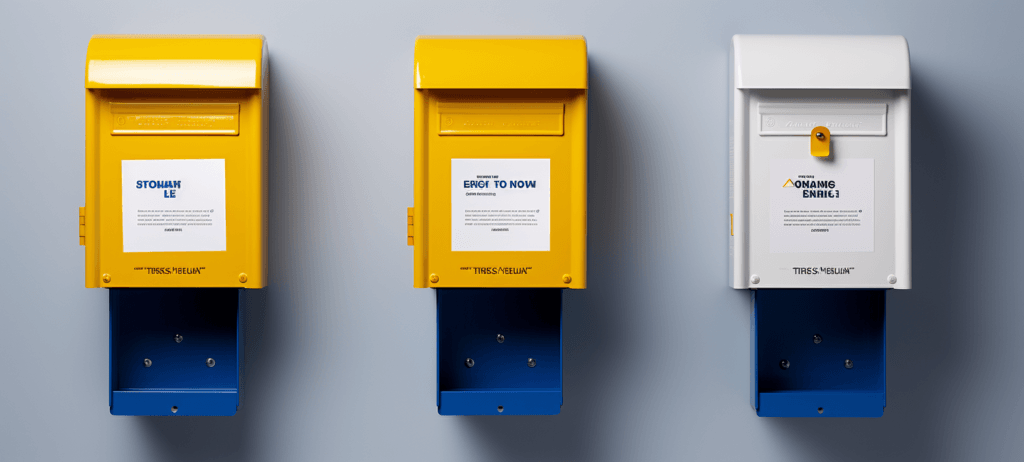-
 7 min. read
7 min. read
-
 Nolan Barger
Nolan Barger Content Writer
Content Writer
- Nolan is an Account Manager for WebFX who has helped optimize campaigns for over 200 accounts. Nolan’s favorite part of digital marketing is being able to have a direct impact on growing his clients’ businesses. In his spare time, he enjoys watching NCAA wrestling, riding his motorcycle, and working on his cabin.
People often think of search engine optimization (SEO) and conversion rate optimization (CRO) as two completely separate strategies. But are they? You might be surprised how much SEO and CRO overlap — and how they work together to drive results.
In 2024 and beyond SEO and CRO should go hand-in-hand. Want to learn more about SEO vs. CRO and why they both need a spot in your marketing plan? Just keep reading — or contact us to learn more!
Time to Level Up Your Sales
Our long list of services helps you grow every aspect of your business with marketing strategies that are proven to increase bottom-line metrics like revenue and conversions.
In the past 5 years, we’ve managed more than 14.9 MILLION transactions across our client base.
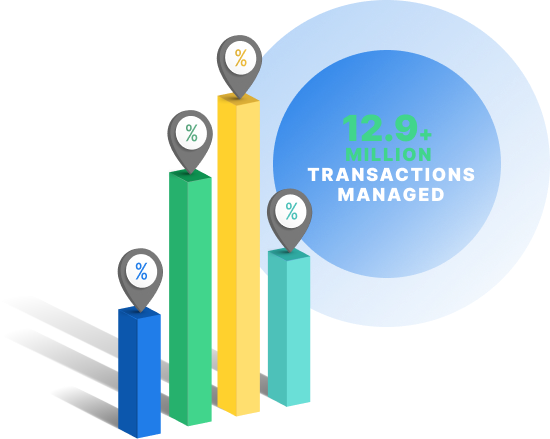
Let’s start with the basics.
What is SEO vs. CRO?
SEO, or search engine optimization, is the process of boosting your website’s rankings in search engines’ organic results. When your site ranks at the top of search results, more people can find your business, visit your site, and ultimately purchase.
CRO, or conversion rate optimization, is the process of continuously testing website elements to earn more conversions, leads, and sales for your business.
While SEO focuses on boosting traffic to your site, CRO aims to convert that traffic by encouraging more people to take action, whether that be signing up for your newsletter, filling out a contact form, or purchasing. In other words, CRO helps you convert more of the traffic you drive with SEO.
How SEO and CRO work together to drive rankings and conversions
As I mentioned above, SEO helps your site rank in search results, so you can earn more traffic to your website.
Sites that don’t rank won’t earn conversions and revenue. But if your goal is solely to rank, you’re doing SEO wrong. Every element of your website should help answer searchers’ queries and move them closer to becoming customers.
So, how do you create content that not only ranks well but also converts visitors?
1. Create SEO content that matches search intent
If you’re familiar with SEO best practices, you likely understand the value of creating website content. Without content, Google would have nothing to rank, and your site wouldn’t attract new visitors. Whether it’s content for your blog or sales-oriented product pages, relevant content is the #1 way to rank for terms that bring you new business.
Google uses numerous factors to determine which pages rank for various search results — and Google wants to display results that answer searchers’ queries and provide a great user experience (UX). In 2024, Google does a better job than ever at matching people with the information they’ll find most valuable. So, if you want to rank in search results and convert visitors, you need to match search intent.
In other words, you need to create content that best answers searchers’ questions and supplies the information they need. To better understand how to match search intent for different types of queries, rank, and drive conversions, let’s look at a few examples.
Example 1: Transactional search
Let’s say I search a phrase with transactional or purchase intent — “buy oil filter 2017 Colorado.” Here’s what Google returns: 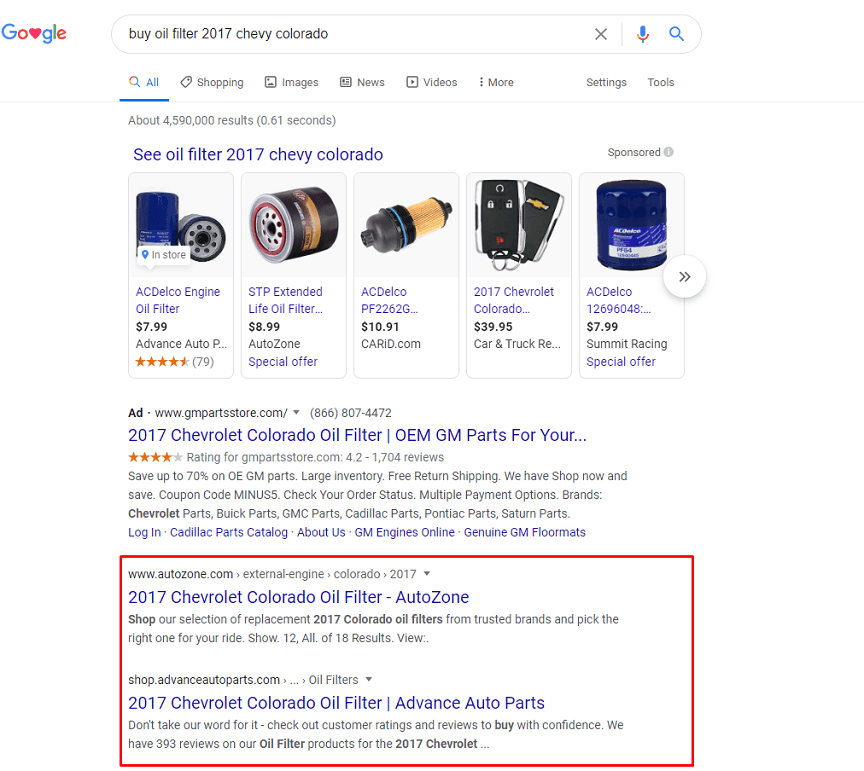 The top two organic results are product pages for buying 2017 Colorado oil filters. Content on these pages includes:
The top two organic results are product pages for buying 2017 Colorado oil filters. Content on these pages includes:
- Product descriptions with key selling points
- Prices for each option
- Reviews
- Where to buy near me
- Shipping options
It’s safe to say that if I needed to buy an oil filter, Auto Zone or Advance Auto Parts would have my business.
Example 2: Informational search
Now, let’s say I conduct an informational search about how to change the oil on my truck. If I search “How to change the oil on my 2017 Colorado,” Google returns the video below as the top organic result. 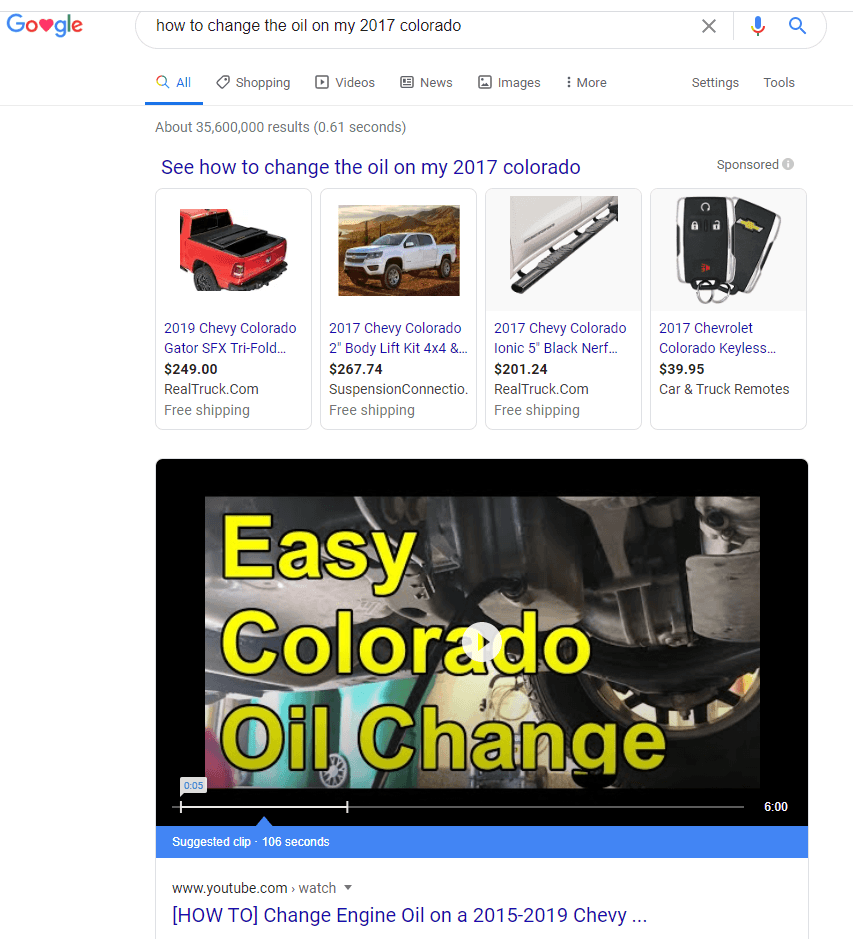 Below the video, the search results include a “People also ask” box followed by several more YouTube videos.
Below the video, the search results include a “People also ask” box followed by several more YouTube videos.
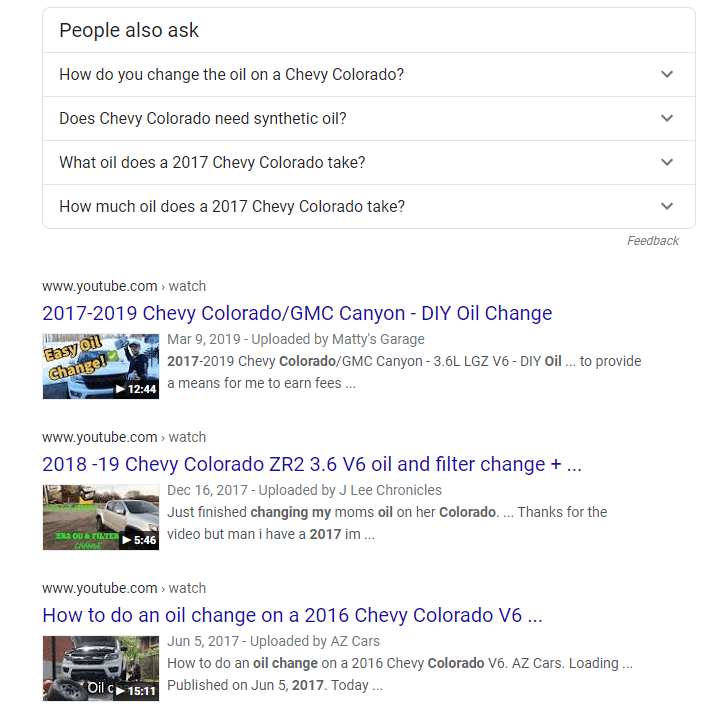 So, let’s say I’m working with a company that manufactures oil filters, and we want to rank for the informational query. Based on what’s currently ranking for that search, our page needs to include the following information to match search intent:
So, let’s say I’m working with a company that manufactures oil filters, and we want to rank for the informational query. Based on what’s currently ranking for that search, our page needs to include the following information to match search intent:
- A video about how to do an oil change
- What oil to use
- How much oil you’ll need
- A title tag that includes the vehicle year, make/model, and engine type
Attempting to rank a product page for the example query wouldn’t work because it doesn’t match the intent behind the search — it doesn’t answer how to change the oil. Matching search intent helps websites rank and earn more traffic, but how do we get that traffic to convert?
2. Optimize content for conversions
To help turn visitors into conversions, you’ll want to add call to action (CTA) text or buttons that link to conversion-focused content. Including strategic CTAs funnels traffic from blog posts and TOFU pages to product pages or contact/quote forms. In example two above, top-ranking pages feature informational content to first and foremost answer the searcher’s query — before introducing products.
But those pages also include strategic CTAs to encourage people to learn more about product offerings. Writing content that meets the needs of searchers improves their experience on your site — and it makes sense that they’ll be more likely to convert, too. Creating content that matches search intent and including clear CTAs that move visitors down the marketing funnel will lead to higher website conversion rates.
Bonus Read: Your 9-Point CRO Checklist
SEO and CRO case study: Why Amazon ranks and converts so well
Let’s look at another example.
I frequently use Amazon as an SEO and CRO example for my ecommerce clients. Among other things, like being a highly authoritative website, Amazon’s content is engaging and provides value to searchers, so Amazon pages often rank very well in Google searches. In addition, Amazon pages contain elements designed to encourage conversions.
Think about it — what makes you buy something on Amazon that you’ve never bought before? Maybe a few of the things listed below:
- Product reviews and product reviews with images
- Q&As about the product
- An accurate description
- Free shipping
- Fast ship time
- Clear images
- Videos of the product
- Knowledge and trust of Amazon’s checkout and security
Amazon ranks and converts by creating valuable, engaging content and providing visitors with the information they need to feel comfortable buying.
Looking for an all-in-one SEO audit tool? You’ve found it.
SEO Checker provides data on key metrics to give you:
- Complete SEO score
- Content Grade
- Site Speed Analysis
- and more.

3 SEO and CRO tips
Now that you know how to create content that ranks and drives conversions, let’s look at a few other SEO and CRO tips.
1. Optimize title tags and meta descriptions
To rank and convert site traffic, you’ll want to create accurate title tags and meta descriptions that describe exactly what searchers can expect to find on your pages. If your title tags and meta descriptions accurately describe the content, you’ll drive more relevant traffic to your site, and you’ll see engagement metrics rise, while bounce rates drop.
2. Optimize content for mobile
Today, more than half of search traffic comes from mobile devices. If your content isn’t optimized for mobile, you’ll miss out on valuable leads and conversions. Make sure that the most important content always displays above the fold on mobile devices.
For product pages, this could be content such as brief specs, product price, shipping costs, reviews, and product images. This makes it easier for mobile users to quickly find the information they need and take the next steps to convert.
3. Test. Test. Test.
Tools like Google Optimize help you easily A/B test elements on your website to drive more conversions.
With CRO tools, you can collect and analyze data on how users interact with different versions of your pages. Then, you can optimize your content by including elements that convert more visitors.
Now let’s get to optimizing!
SEO and CRO should go hand-in-hand if you expect to reach and convert leads. That said, optimizing a website to both rank in Google results and convert site visitors requires time and expert insights.
WebFX knows what it takes to boost rankings and conversions. In the last five years, we’ve driven 24 million leads and $6 billion in revenue for our clients. If you’re interested in generating more sales from your SEO efforts, reach out to WebFX today for a free content and conversion analysis!
-
 Nolan is an Account Manager for WebFX who has helped optimize campaigns for over 200 accounts. Nolan’s favorite part of digital marketing is being able to have a direct impact on growing his clients’ businesses. In his spare time, he enjoys watching NCAA wrestling, riding his motorcycle, and working on his cabin.
Nolan is an Account Manager for WebFX who has helped optimize campaigns for over 200 accounts. Nolan’s favorite part of digital marketing is being able to have a direct impact on growing his clients’ businesses. In his spare time, he enjoys watching NCAA wrestling, riding his motorcycle, and working on his cabin. -

WebFX is a full-service marketing agency with 1,100+ client reviews and a 4.9-star rating on Clutch! Find out how our expert team and revenue-accelerating tech can drive results for you! Learn more
Try our free Marketing Calculator
Craft a tailored online marketing strategy! Utilize our free Internet marketing calculator for a custom plan based on your location, reach, timeframe, and budget.
Plan Your Marketing Budget
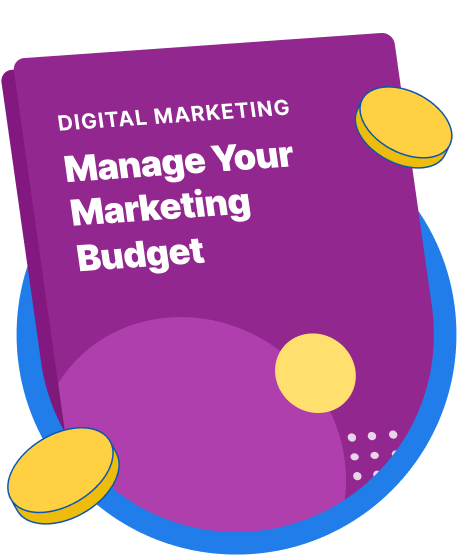
Maximize Your Marketing ROI
Claim your free eBook packed with proven strategies to boost your marketing efforts.
Get the GuideTry our free Marketing Calculator
Craft a tailored online marketing strategy! Utilize our free Internet marketing calculator for a custom plan based on your location, reach, timeframe, and budget.
Plan Your Marketing Budget




